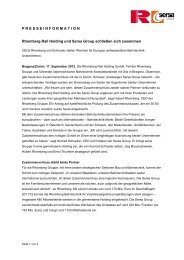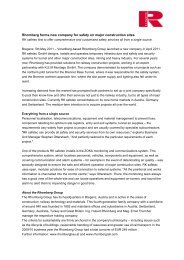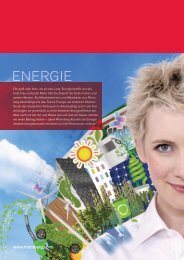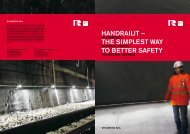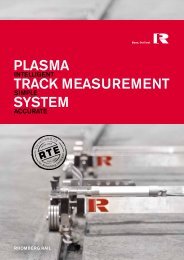BEING MOBILE - Rhomberg Bau
BEING MOBILE - Rhomberg Bau
BEING MOBILE - Rhomberg Bau
Create successful ePaper yourself
Turn your PDF publications into a flip-book with our unique Google optimized e-Paper software.
mobilitY<br />
A few thoughts on mobility<br />
Cars are stuck in a traffic jam. Cyclists are sweating. The overfilled<br />
buses and trains stink. Walking is too much like hard<br />
work. So why not stay at home and enjoy the life of a couch<br />
potato? How much more fun was life 50 years ago, when<br />
Austrian writer Helmut Qualtinger intoned in his Austrian<br />
vernacular: “I may not have a clue where I am going, but at<br />
least I will get there quicker!” Then as now, the key word was<br />
progress. Movement. Mobility. Whatever – just keep moving.<br />
Never mind where to. And: whatever you do, don’t think about<br />
it. Clearly, thinking must be proving something of a challenge<br />
if we are so heavily reliant on such an inefficient means of<br />
transport as our conventional cars, with a real efficiency of<br />
between 20% (petrol cars) and 30% (diesels). Not to mention<br />
the fact that these vehicles spend upwards of 90% of<br />
their lives standing still, either in traffic jams or in the garage.<br />
Consequently, some might equate cars more with standing<br />
still see them as an expression of mobility.<br />
But, in the case of electric cars, the fact that cars spend so<br />
much time doing nothing is precisely what can be turned to<br />
our advantage – by using their batteries as storage for basic,<br />
economy-rate electricity which can then be used as ondemand<br />
peak-rate electricity. Smart Grids make this possible.<br />
This type of intelligent network – which is still under development<br />
– balances large numbers of electricity generators, consumers<br />
and storage devices for electrical energy in the most<br />
energy and cost-efficient manner, and it can also revolutionize<br />
our mobility. Just imagine a global network of cars, trams,<br />
trains, buses, bicycles and mopeds – all powered with electricity<br />
from renewable energy carriers – which are interlinked<br />
with each other in such a way that everybody on earth can access<br />
the most appropriate means of transportation at any time.<br />
Maybe ships and airplanes can join in as well.<br />
Impossible? But why? What is only just beginning with Smart<br />
Grids in the electricity sector definitely does not need to end<br />
there. We already have all the necessary pieces in our hands,<br />
now we just need to put them together intelligently.<br />
In any case, the Kyoto Protocol sets out a reduction of greenhouse<br />
gases which is binding under international law – and<br />
transportation is one of the key culprits. Not to mention the<br />
fact that the current economic crisis is having a serious impact<br />
on the automotive industry. Plus – of course – oil reserves will<br />
run out in due course.<br />
But none of this will be a problem if we learn how to tune in<br />
to making the best use of our mobility<br />
Willi Sieber, Austrian Ecology Institute<br />
7



